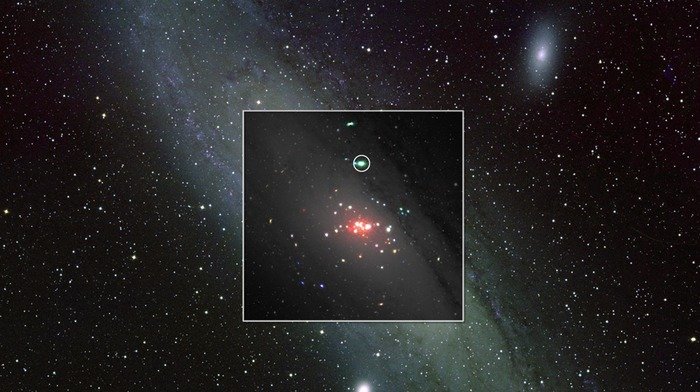This image composites X-ray data onto an optical view of the Andromeda galaxy; the ULX is circled. Credit: Bill Schoening, Vanessa Harvey/REU program/NOAO/AURA/NSF
GREENBELT, Md., Dec. 13 (UPI) -- The X-ray jet streaming from a binge-eating black hole in the nearby galaxy of Andromeda has been detected, U.S. and European astronomers say.
Classified as an ultraluminous X-ray source or ULX, the object is only the second ever seen in Andromeda, also known as M31, and was the target of an intense observing campaign by orbiting X-ray telescopes and radio observatories on the ground, NASA reported Wednesday.
Astronomers say they believe a ULX is a binary system containing a black hole that is rapidly consuming gas from its stellar companion at a rate very near a theoretical maximum, a feeding frenzy that astronomers say they do not yet fully understand.
"There are four black hole binaries within our own galaxy that have been observed accreting at these extreme rates," Matthew Middleton at the Anton Pannekoek Astronomical Institute in Amsterdam said. "Gas and dust in our own galaxy interfere with our ability to probe how matter flows into ULXs, so our best glimpse of these processes comes from sources located out of the plane of our galaxy, such as those in M31."
As gas is pulled into a black hole, it undergoes compression and heating, eventually becoming so hot it emits X-rays. The X-ray brightness is a good measure of the rate a black hole is consuming its stellar companion, astronomers said.
At some point the X-ray emission becomes so strong it pushes back on the inflowing gas, creating a theoretical limit on the black hole's accretion rate, they said.
"The discovery of jets tells us that this particular ULX is a typical stellar remnant about 10 times the mass of the sun, swallowing as much material as it possibly can," Middleton said. "We may well find jets in ULXs with similar X-ray properties in other nearby galaxies, which will help us better understand the nature of these incredible outflows."















